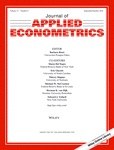
Westerlund, J., Karabiyik, H. and Narayan, P. (2017). Testing for predictability in panels with general predictors Journal of Applied Econometrics, 32(3):554--574.
-
Affiliated author
-
Publication year2017
-
JournalJournal of Applied Econometrics
The difficulty of predicting returns has recently motivated researchers to start looking for tests that are either more powerful or robust to more features of the data. Unfortunately, the way that these tests work typically involves trading robustness for power or vice versa. The current paper takes this as its starting point to develop a new panel-based approach to predictability that is both robust and powerful. Specifically, while the panel route to increased power is not new, the way in which the cross-section variation is exploited also to achieve robustness with respect to the predictor is. The result is two new tests that enable asymptotically standard normal and chi-squared inference across a wide range of empirically relevant scenarios in which the predictor may be stationary, moderately non-stationary, nearly non-stationary, or indeed unit root non-stationary. The type of cross-section dependence that can be permitted in the predictor is also very general, and can be weak or strong, although we do require that the cross-section dependence in the regression errors is of the strong form. What is more, this generality comes at no cost in terms of complicated test construction. The new tests are therefore very user-friendly.